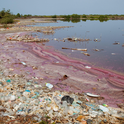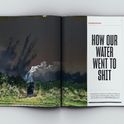DIPPING INTO LIFE ON THE OCEAN WAVE
One of the most remarkable features of the Census of Marine Life is that it was so little known until the announcement of its completion in early October. The ten-year project involved around 2,700 scientists and 540 ocean expeditions, and has generated more than 2,600 scientific papers. It has delved into the ocean biosphere from the coasts of Antarctica to the deepest abysses, followed seabirds and whales and sifted for plankton and bacteria. But all this activity has remained off the media’s radar.
Oceanographers like to say that we know more about the surface of the Moon than about the oceans, 70 per cent of which descend an average of 4km below the sea surface. The oceans are a source of endless eye-popping facts: the deepest trench would easily swallow Mount Everest, and 99 per cent of the biosphere is in or under marine waters. In consequence, it’s understandable that “census” is a rather generous term: there’s nothing definitive about these latest directories of marine dwellers. Although probably around 6,000 new species were identified, the number of known marine species can still only be estimated (around 250,000), and the total number is even more uncertain: perhaps several million, not including microbes (of which there are perhaps a hundred times that many).
So what is all the information for, aside from keeping taxonomists in work? The answer is that the fate of our planet looks ever more bound to the oceans. That’s where vast amounts of atmospheric carbon dioxide are absorbed by new plant growth, which means that changes to ocean ecology are central to climate change. Decimated fish stocks, dying coral reefs, diminishing Arctic sea ice, oil spills, whaling, sea acidification, coastal erosion—the list of environmental problems that bear on marine ecology is a long one. At least now we have some measure of our ignorance.
NOBEL CATCH-UP
The Nobel committee is renowned for waiting until discoveries have stood the test of time before rewarding them—one reason why Einstein’s prize was for the photoelectric effect and not relativity. But it’s surprising that 4m “test-tube babies” were needed to vindicate Robert Edwards, the pioneer of in-vitro fertilisation and winner of this year’s prize for medicine. Had the award been given before 1988, when the technique was already spawning a global industry, he would have shared it with the late Patrick Steptoe, the gynaecologist who turned Edwards’s embryology into a clinical treatment.
But while few Nobel laureates can claim that their work made 4m lives possible, few too can say it represents forbidden fruit for over a billion others. In denouncing Edwards’s award as “completely out of order,” the Vatican’s spokesperson on bioethics, Ignacio Carrasco de Paula, may have been speaking in a personal capacity, but the fact is that the Catholic Church deems almost all forms of IVF “morally unacceptable” because they “dissociate the sexual act from the procreative act” and “entrust the life and identity of the embryo into the power of doctors and biologists.”
It is seldom explained by either the Church or its critics what exactly is wrong with dissociating sex from procreation; for that, we need to look not to the bible but to the theology of “natural law” developed in the 13th century by Thomas Aquinas. According to Aquinas, what happens “naturally” is the result of God’s will and therefore good by definition. Such thinking dissolves in the face of modern scientific understanding, but it seems theology still trumps biology.
ANOTHER PLANET EARTH?
At last we have discovered an Earth-like “Goldilocks” planet outside of our solar system. Gliese 581g, orbiting a star 20 light years away, is rocky, three to four times the size of Earth, and in the habitable zone where the conditions should be “just right” for sustaining liquid water. Notwithstanding the ill-advised certainty with which one of the discoverers voiced the conviction that it hosts life, it is probably scorching on one side (it doesn’t rotate) and freezing on the other. Life might huddle in between, but it’s not exactly balmy up there.
One of the most remarkable features of the Census of Marine Life is that it was so little known until the announcement of its completion in early October. The ten-year project involved around 2,700 scientists and 540 ocean expeditions, and has generated more than 2,600 scientific papers. It has delved into the ocean biosphere from the coasts of Antarctica to the deepest abysses, followed seabirds and whales and sifted for plankton and bacteria. But all this activity has remained off the media’s radar.
Oceanographers like to say that we know more about the surface of the Moon than about the oceans, 70 per cent of which descend an average of 4km below the sea surface. The oceans are a source of endless eye-popping facts: the deepest trench would easily swallow Mount Everest, and 99 per cent of the biosphere is in or under marine waters. In consequence, it’s understandable that “census” is a rather generous term: there’s nothing definitive about these latest directories of marine dwellers. Although probably around 6,000 new species were identified, the number of known marine species can still only be estimated (around 250,000), and the total number is even more uncertain: perhaps several million, not including microbes (of which there are perhaps a hundred times that many).
So what is all the information for, aside from keeping taxonomists in work? The answer is that the fate of our planet looks ever more bound to the oceans. That’s where vast amounts of atmospheric carbon dioxide are absorbed by new plant growth, which means that changes to ocean ecology are central to climate change. Decimated fish stocks, dying coral reefs, diminishing Arctic sea ice, oil spills, whaling, sea acidification, coastal erosion—the list of environmental problems that bear on marine ecology is a long one. At least now we have some measure of our ignorance.
NOBEL CATCH-UP
The Nobel committee is renowned for waiting until discoveries have stood the test of time before rewarding them—one reason why Einstein’s prize was for the photoelectric effect and not relativity. But it’s surprising that 4m “test-tube babies” were needed to vindicate Robert Edwards, the pioneer of in-vitro fertilisation and winner of this year’s prize for medicine. Had the award been given before 1988, when the technique was already spawning a global industry, he would have shared it with the late Patrick Steptoe, the gynaecologist who turned Edwards’s embryology into a clinical treatment.
But while few Nobel laureates can claim that their work made 4m lives possible, few too can say it represents forbidden fruit for over a billion others. In denouncing Edwards’s award as “completely out of order,” the Vatican’s spokesperson on bioethics, Ignacio Carrasco de Paula, may have been speaking in a personal capacity, but the fact is that the Catholic Church deems almost all forms of IVF “morally unacceptable” because they “dissociate the sexual act from the procreative act” and “entrust the life and identity of the embryo into the power of doctors and biologists.”
It is seldom explained by either the Church or its critics what exactly is wrong with dissociating sex from procreation; for that, we need to look not to the bible but to the theology of “natural law” developed in the 13th century by Thomas Aquinas. According to Aquinas, what happens “naturally” is the result of God’s will and therefore good by definition. Such thinking dissolves in the face of modern scientific understanding, but it seems theology still trumps biology.
ANOTHER PLANET EARTH?
At last we have discovered an Earth-like “Goldilocks” planet outside of our solar system. Gliese 581g, orbiting a star 20 light years away, is rocky, three to four times the size of Earth, and in the habitable zone where the conditions should be “just right” for sustaining liquid water. Notwithstanding the ill-advised certainty with which one of the discoverers voiced the conviction that it hosts life, it is probably scorching on one side (it doesn’t rotate) and freezing on the other. Life might huddle in between, but it’s not exactly balmy up there.












